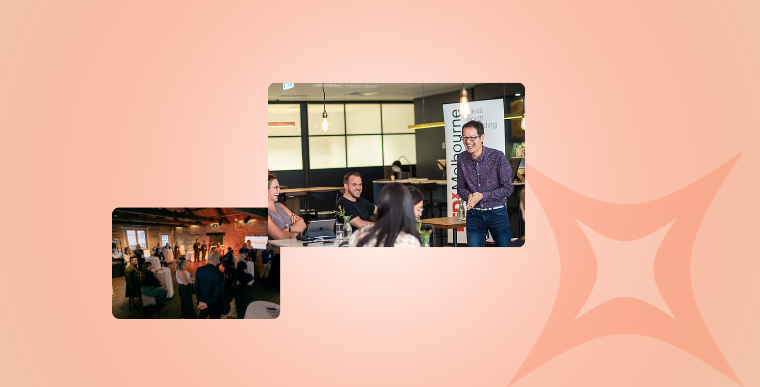
Working at TEDxMelbourne, Jon Yeo knows a thing or two about public speaking.
He says that both this role and his position as president of the National Speakers Association gave him the chance to work with some of the world’s best professional speakers.
“For every minute they’re on stage, there’s 27 hours of preparation,” he shares, “and that’s Olympic-level professionalism.”
Thankfully, he explains, you don’t need to train like a world-class professional to become a great orator. Indeed, just a few key public speaking tips can get you a long way.
We were lucky enough to host Jon at our recent lunch and learn session in Melbourne. Read on to discover some of his top skills for speakers to boost your communication, influence and impact.
Understand communication
Jon says one of the most important public speaking tips is to learn about communication as a discipline.
“I know that sounds obvious. We’re taught to read and write at school, but we’re not taught how to speak or influence,” he explains.
Luckily, there are lots of resources to explore. You might start by exploring TED talks or other video content or even by reading up on key concepts like rhetoric.
While exploring new ideas, insights and skills for speakers will certainly help you hone your skills, Jon says communication can be seen as two simple things.
“It’s having something relevant to say, and it’s the ability to communicate that in an engaging way.”
He adds this is the secret to great TEDx talks.
“It combines the relevance and engagement in a way that people will talk about an idea worth spreading, even if it’s a topic they wouldn’t have heard about before.”
Know your audience
According to Jon, understanding your audience isn’t just one of the most important public speaking tips, but it’s also the one people know the least about.
Yet, he says, knowing who you’re speaking to is key to crafting a compelling, engaging speech.
“When I work with a CEO to do a ten-minute speech at an AGM, 80% of our time goes into the audience analysis, and to do a complete analysis takes about three days,” he shares.
“That’s how important it is that the message needs to land the moment it comes out of that person’s mouth.”
However, Jon says you don’t need three days to get the benefit of audience analysis for your next talk. Instead, take some time to think about your audience and consider:
- What they know
- What they expect from you
- What they want
- What their biases or assumptions are
- What their role or projects are
- What their priorities are
- How they might perceive you
While your analysis shouldn’t fundamentally change what you’re planning to say, it can help you adapt your content to better meet your audience’s expectations and needs.
For example, you might avoid over-explaining industry-specific concepts when addressing a group of professionals from that industry, or you might decide to create a more informal speech if you’re addressing a smaller group.
Leverage your strengths
It can be easy to become overwhelmed trying to keep up with all the public speaking tips you read and hear. That’s why Jon recommends identifying your strengths and leaning into them.
“As Bruce Lee says, ‘I’m much more fearful of the man who’s done one punch ten thousand times than the man who knows how to do ten thousand punches,’” Jon explains.
“Find what you’re really good at, whether it’s your character, your charisma, your language, your skill, your capability, your wisdom or insight,” he adds.
“Let that be your differentiating factor as a communicator and be known for that because then you’ve got a foundation that you can count on.”
For example, you might be great at audience interaction, body language or speaking in a charismatic and engaging way.
Finding your strengths might be as simple as thinking about which elements of public speaking you enjoy the most or which aspects you feel you’re best at. If you’re unsure, it can be good to ask a friend or trusted colleague for their feedback.
Once you know your strengths, you can design your presentations to make the best use of them.
Engage, don’t lecture
“I always tell my TEDxMelbourne speakers, it’s a TED talk, not a TED lecture,” Jon quips.
He says it’s all too easy — and all too common — for speakers to fall into the trap of talking at their audience rather than talking to them.
“You never go to a dinner party, sit next to a complete stranger and say, ‘Let me talk at you for the next 15 minutes, you’ll be fascinated’, yet that’s what so many people try to do in these longer-form communications.”
He says the key is to build trust and rapport with your audience. Luckily, there are a few specific public speaking tips that can help with this.
- Remain calm and clear – “If you speak slower and clearer, people automatically assume you are more intelligent,” Jon explains.
- Use pregnant pauses – Not only do pauses give you and your audience a moment to reflect, but they can also help you appear more confident and comfortable, building trust.
- Include rhetorical questions – Rhetorical questions are a key element of persuasive speaking. They’re impactful because they challenge your audience to engage intellectually with your talk.
- Get interactive – Inviting your audience to interact with you can help build rapport. For example, when introducing a concept, you could ask for a show of hands from whoever has heard of it before.
- Move around – Gestures and body language, including good eye contact, an open posture and relaxed hand movements, make up some of the most important skills for speakers. These movements show that you are comfortable and create visual interest.
- Keep it simple – Jon says if your message isn’t simple, it’s too complicated. “If it’s clear in your head, it can be clear in their head. But if it’s not clear in your head, your audience hasn’t got a chance.”
Find out more
At evexus, we’re proud to be a part of the events community. In addition to our world-class event management software, we offer a range of resources like our Lunch and Learn sessions to help you create better, more impactful event experiences.
Head to the evexus blog to discover more news and insights, or follow us on LinkedIn, Instagram or Facebook to stay in the loop about upcoming events.









